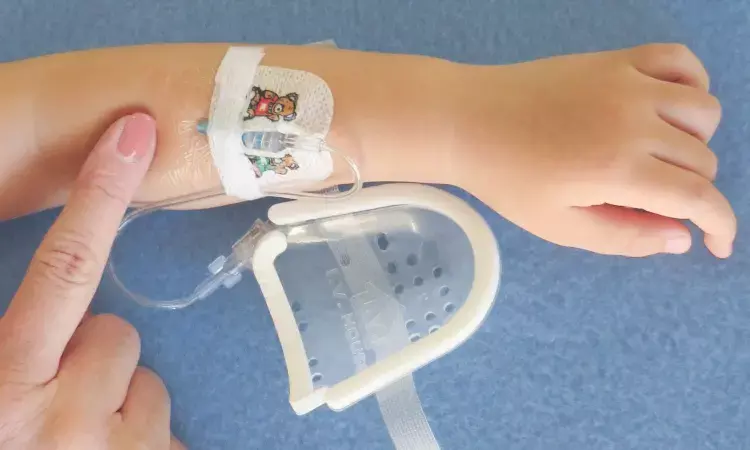- Home
- Medical news & Guidelines
- Anesthesiology
- Cardiology and CTVS
- Critical Care
- Dentistry
- Dermatology
- Diabetes and Endocrinology
- ENT
- Gastroenterology
- Medicine
- Nephrology
- Neurology
- Obstretics-Gynaecology
- Oncology
- Ophthalmology
- Orthopaedics
- Pediatrics-Neonatology
- Psychiatry
- Pulmonology
- Radiology
- Surgery
- Urology
- Laboratory Medicine
- Diet
- Nursing
- Paramedical
- Physiotherapy
- Health news
- Fact Check
- Bone Health Fact Check
- Brain Health Fact Check
- Cancer Related Fact Check
- Child Care Fact Check
- Dental and oral health fact check
- Diabetes and metabolic health fact check
- Diet and Nutrition Fact Check
- Eye and ENT Care Fact Check
- Fitness fact check
- Gut health fact check
- Heart health fact check
- Kidney health fact check
- Medical education fact check
- Men's health fact check
- Respiratory fact check
- Skin and hair care fact check
- Vaccine and Immunization fact check
- Women's health fact check
- AYUSH
- State News
- Andaman and Nicobar Islands
- Andhra Pradesh
- Arunachal Pradesh
- Assam
- Bihar
- Chandigarh
- Chattisgarh
- Dadra and Nagar Haveli
- Daman and Diu
- Delhi
- Goa
- Gujarat
- Haryana
- Himachal Pradesh
- Jammu & Kashmir
- Jharkhand
- Karnataka
- Kerala
- Ladakh
- Lakshadweep
- Madhya Pradesh
- Maharashtra
- Manipur
- Meghalaya
- Mizoram
- Nagaland
- Odisha
- Puducherry
- Punjab
- Rajasthan
- Sikkim
- Tamil Nadu
- Telangana
- Tripura
- Uttar Pradesh
- Uttrakhand
- West Bengal
- Medical Education
- Industry
Midline catheters safer for shorter infusion durations compared to peripherally inserted central catheters: JAMA

A recent large-scale retrospective study published in the Journal of American Medical Association found the comparative safety of midline catheters versus peripherally inserted central catheters (PICCs) for outpatient parenteral antimicrobial therapy (OPAT), a treatment often used following hospital discharge. The research spanned from January 2017 to November 2023 was conducted across 69 Michigan hospitals and was analyzed from April to June 2024.
The study included a total of 2,824 patients, of whom 1,487 (53.5%) were male, with a median age of 66.8 years. In total, 1,999 midline catheters (70.8%) and 825 PICCs (29.2%) were inserted for OPAT. The cases involving vancomycin therapy were excluded to ensure a focus on peripherally compatible treatments.
The key outcomes measured were major device complications, including catheter-related bloodstream infections and venous thromboembolism. Secondary outcomes assessed were minor complications such as catheter dislodgement, occlusion, tip migration, infiltration, superficial thrombophlebitis, and exit site issues, along with overall device failure indicated by the removal due to these complications.
The findings of the study showed that major device complications occurred in only 1.6% of patients overall. Also, midline catheters had a significantly lower rate of major complications (0.8%) when compared to PICCs (3.4%). The adjusted hazard ratio (aHR) for major complications with midline catheters was 0.46 (95% CI, 0.23-0.91) by highlighting a marked reduction in risk.
Further analysis based on the duration of device use revealed that midline catheters were especially beneficial for short-term use (up to 14 days). In this group, only 0.9% of midline catheter users experienced major complications when compared to 5.3% for PICC users (aHR, 0.29; 95% CI, 0.12-0.68). Also, for device use longer than 14 days, the difference in major complication rates was not significant (0.6% for midline catheters vs. 2.3% for PICCs; aHR, 0.42; 95% CI, 0.13-1.40).
Minor complications and device failure rates were found to be comparable between the two groups, with minor issues affecting 10.3% of midline catheter users versus 13.8% of PICC users (aHR, 1.07; 95% CI, 0.83-1.38). The device failure rates were also similar, at 9.6% for midline catheters and 12.1% for PICCs (aHR, 1.26; 95% CI, 0.96-1.65). Overall, the outcomes underline that midline catheters can be a safer alternative to PICCs for OPAT, particularly when therapy is expected to last for 14 or fewer days.
Source:
Paje, D., Walzl, E., Heath, M., McLaughlin, E., Horowitz, J. K., Tatarcuk, C., Swaminathan, L., Kaatz, S., Malani, A. N., Vaughn, V. M., Bernstein, S. J., Flanders, S. A., & Chopra, V. (2024). Midline vs Peripherally Inserted Central Catheter for Outpatient Parenteral Antimicrobial Therapy. In JAMA Internal Medicine. American Medical Association (AMA). https://doi.org/10.1001/jamainternmed.2024.5984
Neuroscience Masters graduate
Jacinthlyn Sylvia, a Neuroscience Master's graduate from Chennai has worked extensively in deciphering the neurobiology of cognition and motor control in aging. She also has spread-out exposure to Neurosurgery from her Bachelor’s. She is currently involved in active Neuro-Oncology research. She is an upcoming neuroscientist with a fiery passion for writing. Her news cover at Medical Dialogues feature recent discoveries and updates from the healthcare and biomedical research fields. She can be reached at editorial@medicaldialogues.in
Dr Kamal Kant Kohli-MBBS, DTCD- a chest specialist with more than 30 years of practice and a flair for writing clinical articles, Dr Kamal Kant Kohli joined Medical Dialogues as a Chief Editor of Medical News. Besides writing articles, as an editor, he proofreads and verifies all the medical content published on Medical Dialogues including those coming from journals, studies,medical conferences,guidelines etc. Email: drkohli@medicaldialogues.in. Contact no. 011-43720751


